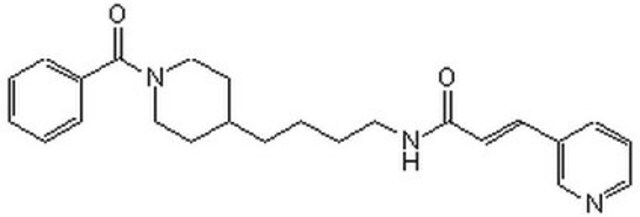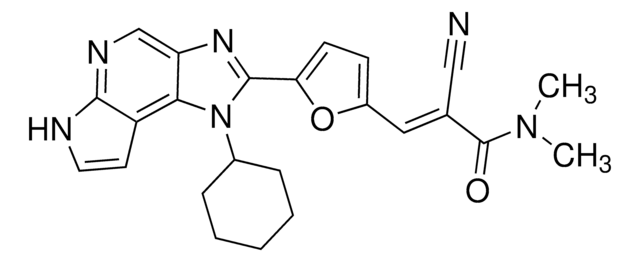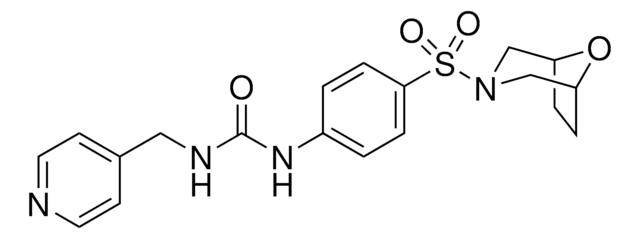Wichtige Dokumente
D8446
P7C3
≥98% (HPLC)
Synonym(e):
3,6-Dibromo-a-[(phenylamino)methyl]-9H-carbazole-9-ethanol
About This Item
Empfohlene Produkte
Assay
≥98% (HPLC)
Form
powder
Farbe
white to off-white
Löslichkeit
DMSO: 34 mg/mL
Lagertemp.
2-8°C
SMILES String
OC(CNc1ccccc1)Cn2c3ccc(Br)cc3c4cc(Br)ccc24
InChI
1S/C21H18Br2N2O/c22-14-6-8-20-18(10-14)19-11-15(23)7-9-21(19)25(20)13-17(26)12-24-16-4-2-1-3-5-16/h1-11,17,24,26H,12-13H2
InChIKey
FZHHRERIIVOATI-UHFFFAOYSA-N
Anwendung
Biochem./physiol. Wirkung
Degeneration of the hippocampus is an early manifestation of Alzheimer′s disease. P7C3 promotes neurogenesis in the subgranular zone of the hippocampal dentate gyrus, the site of normal neurogenesis in adult mammals, making it an important lead compound in development of new Alzheimer′s treatments.
Signalwort
Danger
H-Sätze
Gefahreneinstufungen
Acute Tox. 3 Oral - Eye Dam. 1
Lagerklassenschlüssel
6.1C - Combustible acute toxic Cat.3 / toxic compounds or compounds which causing chronic effects
WGK
WGK 3
Flammpunkt (°F)
Not applicable
Flammpunkt (°C)
Not applicable
Hier finden Sie alle aktuellen Versionen:
Analysenzertifikate (COA)
Die passende Version wird nicht angezeigt?
Wenn Sie eine bestimmte Version benötigen, können Sie anhand der Lot- oder Chargennummer nach einem spezifischen Zertifikat suchen.
Besitzen Sie dieses Produkt bereits?
In der Dokumentenbibliothek finden Sie die Dokumentation zu den Produkten, die Sie kürzlich erworben haben.
Unser Team von Wissenschaftlern verfügt über Erfahrung in allen Forschungsbereichen einschließlich Life Science, Materialwissenschaften, chemischer Synthese, Chromatographie, Analytik und vielen mehr..
Setzen Sie sich mit dem technischen Dienst in Verbindung.










